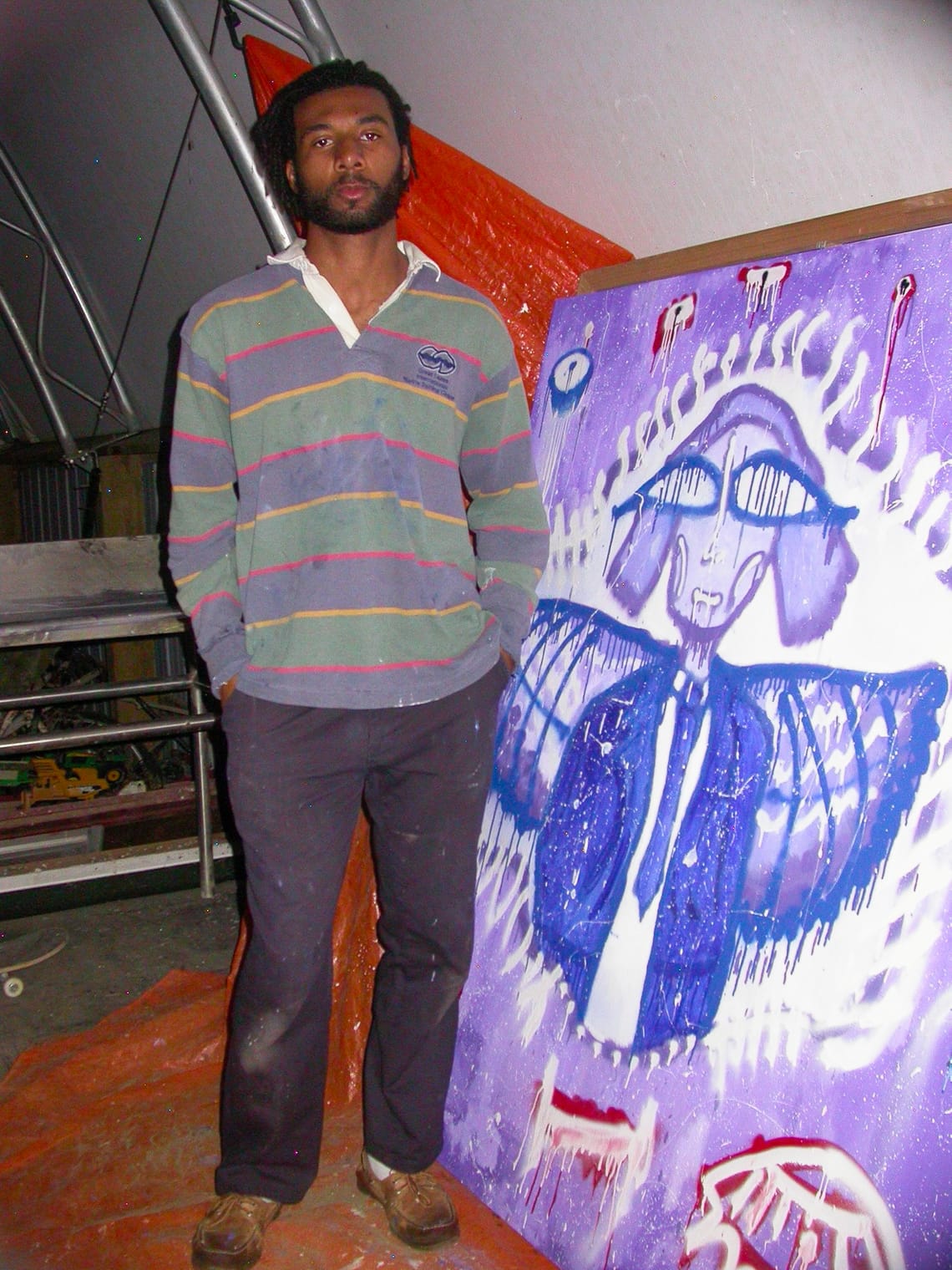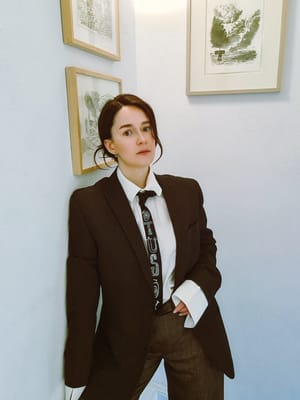
#008 - Manny Brinton
Welcome to our interview series, where we interview emerging creatives all over the globe!
Today, we will be interviewing Manny Brinton, a Canadian visual storyteller whose art blends imagination, identity, and emotion into vivid characters and worlds. Deeply inspired by Jean-Michel Basquiat, Manny’s work is driven by spontaneity, personal reflection, and a desire to bring unseen ideas to life. His creative process balances thoughtful planning and intuition, and his pieces often reflect his emotional state and life experiences. Through both painting and photography, Manny captures not only moments but the ongoing process of self-discovery and creative growth.
With that being said, we will now dive into the questions we have prepared for Manny!
Hey, Manny! We appreciate your interest in taking part in the FTWS interview series. Let's begin with our first question: In what ways do you tell stories in your art? What feelings or ideas do you want to portray?
I tell stories in my art through the characters and worlds created in my artwork. These characters have an identity, come from somewhere, and experience things like we do. My characters and worlds are not living and breathing organisms but real because they exist in the real world. I have made up characters and stories in my journals since I was a kid, and I have continued that practice, but now through different mediums. I love movies and fiction so much because you can get lost in the story and step into the realm of the characters in the story. The idea I want to portray through my work is that so many unseen worlds and characters exist in our minds. Art allows us to bring these stories to life so others can relate. My imagination is the main source of inspiration for my art and is the reason the characters and worlds I have created exist.
Which artists have had the most influence on your work, and how have they influenced your style?
Artist Jean-Michel Basquiat has influenced my work most and is the main reason why I decided to become an artist. In 2020, I came across a short documentary on YouTube about him, and I was captivated by his art and how he carried himself as an individual. He had this energy to him that he could be whatever he wanted and didn't care what other people thought about him or his work. I was drawn to his uniqueness and his style. It was unlike anything I had ever seen before. After watching that documentary, I was motivated to try making art myself, regardless of how it looked. Basquiat's bold, childlike, and free-flowing style has influenced my style because it revealed to me that art doesn't always need to be hyper-realistic and can be whatever you want it to be. I think Basquiat's free-spirited influence has changed how I see art. I make it because I want it to exist have a place in the world.
Could you explain your creative process to us? Do you allow spontaneity to guide your work, or do you plan every detail beforehand?
My creative process is me visualizing the work before I begin doing anything. I like having a rough idea of what it will look like before I start. After seeing it, I typically sketch the details while writing my thoughts about the concept. Once I start making the work, the process becomes intuitive. I focus on the details I have constructed beforehand and try not to focus too much on replicating the original idea. The exciting part about my creative process is that the final product never turns out to be the same thing I had envisioned from the beginning. It becomes something.
How has your artistic approach changed over time, and are there any particular events or situations that influenced it?
My artistic approach has changed over time because, in the beginning, when I first started, I was hyper-fixated on trying to perfect an idea. How it's changed over time is that now I don't focus too much on trying to perfect an idea but focus more on trying to get the idea to exist in the world and watching it evolve and change into something else over time. It's important for artists to create things and have them be as they are instead of trying to make it this perfect product. What's influenced my change in artistic approach was primarily me speaking to different artists, talking to professors and getting their advice on how they approach their work and how they create things. This change in process involves a lot of experimenting, stepping out of your comfort zone, trying to do things you haven't done before, and exploring what's in it, which makes it intriguing, worth investigating, and worth exploring.
Which of your projects was the most difficult, and what did you take away from the experience?
My painting Killer Instinct was the most challenging project I worked on and probably the longest. The painting has so many components that were not planned initially but developed as I was creating this piece. I used an old anatomy textbook as a reference for the human figures in this piece, and it wasn't easy to put the anatomy source material into my own style. I eventually found a way to make it work using spray paint. I like how the spray paint drips and melts on the canvas, and this was an important aspect for some of the body parts seen in the painting, like the eyes, torso, spine, etc. The one takeaway from this experience was that sometimes more isn't always better when creating art. I had included so many elements in this painting, and it is by far my most elaborate work to date, but I want to try experimenting with a more minimal approach and see how it compares to this work.
Do you consider art to be a kind of self-discovery or therapy, and how does your personal life and emotional state impact your work?
Yes, art is both a kind of self-discovery and therapy. I had an exhibit a couple of years ago titled Finding Yourself. That was my first exhibit, and the main idea behind it was a feeling that I had found myself through art. Art helped me discover a part of myself I wasn't engaged with before. It truly unlocked a creative side about me that was within me all along; I just had to find it within myself.
I think the actual practice of making art can be therapeutic. Art unlocks and brings to light many repressed emotions. It helps us communicate to other people what we're feeling because sometimes it is hard to articulate our emotions. Art gives us that tool to communicate to others what we're trying to say about ourselves and about how we're feeling.
I think my personal life affects my work in many ways. Some of the details in my art are influenced by the life events and experiences happening around me in real time. It's a way to transform or repurpose that into a new form. My emotional state impacts my work through the subject matter, the colours I use, the title, and the intricate details that go into the piece. That's a driving force for how my emotional state impacts my work.
What function do you think painting and photography serve in the modern world? Do you consider your work to be a kind of personal expression, documentation or activism?
We live in a world where things change very rapidly and move so fast all the time., and I think photography and painting slow things down; I think people appreciate art more and take time to enjoy it more when they're removed from their fast-paced lives and constantly being on the go, doing things, going places, going to work, and seeing people.
When I stop to see a painting in a gallery or at a coffee shop or wherever, I can't help but stop to take some time and appreciate what is in front of me and think about the time it took for somebody to create that piece because it does take a lot of time to create artwork. It doesn't have to always, of course, but I think a lot of time and thought goes into it.
I do believe my job is to be a kind of personal expression. My artwork is an extension of myself. It's separate from me, but at the same time, it's a part of me because these ideas, these things in my mind, I'm bringing them to life through my creativity.
And with photography I'm documenting all this stuff. I take photos of my work. I'm taking pictures of myself during the process. I think it's important to document these things so that throughout your career as you progress; you can look back on all the things you've accomplished and how far you've come since the beginning. It's beautiful to see the progression in your career as an artist, how much things have changed, how your thoughts have changed, and how you see that growth.
I'm not deliberately trying to convey a message in all my artworks. Sometimes it's more subtle. Sometimes it's loud. It depends on what's happening in the world and my thoughts and feelings towards it. Sometimes, I want people to appreciate what's on the canvas, what they're looking at, and what they see in my work rather than trying to throw a message in their faces. I want them to appreciate the work.
You can find Manny Brinton’s work below:
Get Featured: https://forms.gle/iMEu3NouFWTWKwo78
Donate: https://paypal.me/NaolDenko

